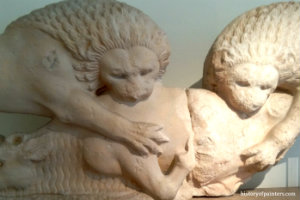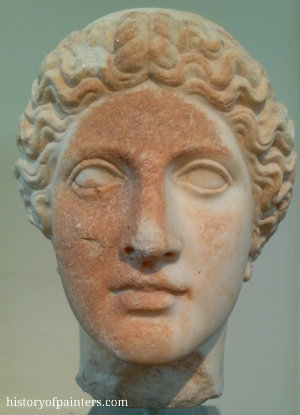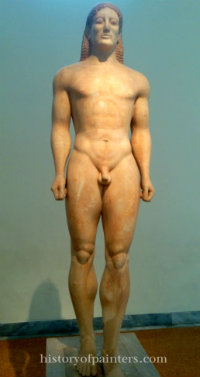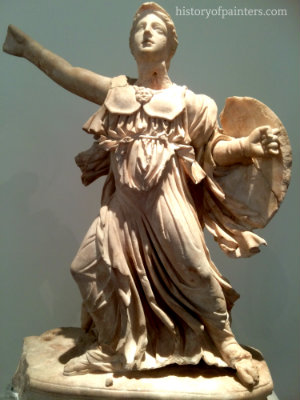Classical Greek Sculpture
The Greeks were able to create life-like sculptures by a continuous struggle with technical problems, by dedicated and direct study of nature, and by the developing a artistic tradition in different schools and families. Sadly very little Greek sculpture has survived. This is partly due to the fact that In Medieval times, Greek statues were an unwelcome reminder of past paganism. The beautiful statues were reduced to ashes by the thousands in order to make cement for new construction. Archeologist have found medieval lime kilns in practically all major Greek archaeological sites. Luckily the Romans were a rather unoriginal bunch in terms of art and copied many Greek sculptures. It is through these copies that we are able to see the genius of the ancient Greek sculptors.
F. B. Tarbell, distinguished Greek historian explains "Greek sculpture may be classified, according to the purposes which it served, under the following heads:
(1) Architectural sculpture. A temple could hardly be considered complete unless it was adorned with more or less of sculpture. The chief place for such sculpture was in the pediments and especially in the principal or eastern pediment. Relief-sculpture might be applied to Doric metopes or an Ionic frieze. And finally, single statues or groups might be placed, as acroteria, upon the apex and lower corners of a pediment. Other sacred buildings besides temples might be similarly adorned. But we hear very little of sculpture on secular buildings.
(2) Cult-images. As a rule, every temple or shrine contained at least one statue of the divinity, or of each divinity, worshiped there.
(3) Votive sculptures. It was the habit of the Greeks to present to their divinities all sorts of objects in recognition of past favors or in hope of favors to come. Among these votive objects or ANATHEMETA works of sculpture occupied a large and important place. The subjects of such sculptures were various. Statues of the god or goddess to whom the dedication was made were common; but perhaps still commoner were figures representing human persons, either the dedicators themselves or others in whom they were nearly interested. Under this latter head fall most of the many statues of victors in the athletic games. These were set up in temple precincts, like that of Zeus at Olympia, that of Apollo at Delphi, or that of Athena on the Acropolis of Athens, and were, in theory at least, intended rather as thank-offerings than as means of glorifying the victors themselves.
(4) Sepulchral sculpture. Sculptured grave monuments were common in Greece at least as early as the sixth century. The most usual monument was a slab of marble—the form varying according to place and time—sculptured with an idealized representation in relief of the deceased person, often with members of his family.
(5) Honorary statues. Statues representing distinguished men, contemporary or otherwise, could be set up by state authority in secular places or in sanctuaries. The earliest known case of this kind is that of Harmodius and Aristogiton, shortly after 510 B.C. (cf. pages 160-4). The practice gradually became common, reaching an extravagant development in the period after Alexander.
(6) Sculpture used merely as ornament, and having no sacred or public character. This class belongs mainly, if not wholly, to the latest period of Greek art. "
.

To view larger images of Greek art images click here

To view larger images of Greek art images click here
During the early period of Greek art the ambition of the sculptor was to achieve complete mastery over the stone and perfect the bodily form. According to classical Greek historian, Ernest Arthur Gardner, "Now the Greek sculptor, as a rule, did not work from an individual model at all. He trusted partly, especially in earlier times, to the tradition which familiarized him with a few fixed types, on which he made variations, partly to his observation and memory trained for generations, and daily supplied with new material in the gymnasium where nude youths and men were constantly exercising, or in the marketplace where he met his fellow-citizens. To see before him, whether draped or nude, the figures he wanted for his art, he had no need to pose a model in a studio; his models were at all times around him in his daily life. The result was that when he wished to represent a youth or a maiden, or even to make a portrait of a statesman, he tended to reproduce the type with certain personal modifications rather than to produce a portrait in the modern sense."
F. B. Tarbell states "In the production of a modern piece of marble sculpture, the artist first makes a clay model and then a mere workman produces from this a marble copy. In the best period of Greek art, on the other hand, there seems to have been no mechanical copying of finished models. Preliminary drawings or even clay models, perhaps small, there must often have been to guide the eye; but the sculptor, instead of copying with the help of exact measurements, struck out freely, as genius and training inspired him. If he made a mistake, the result was not fatal, for he could repair his error by attaching a fresh piece of marble. Yet even so, the ability to work in this way implies marvelous precision of eye and hand. To this ability and this method we may ascribe something of the freedom, the vitality, and the impulsiveness of Greek marble sculpture—qualities which the mechanical method of production tends to destroy. Observe too that, while pediment-groups, metopes, friezes, and reliefs upon pedestals would often be executed by subordinates following the design of the principal artist, any important single statue or group in marble was in all probability chiseled by the very hand of the master."
Tarbel suggests "Another fact of importance, a fact which few are able to keep constantly enough in their thoughts, is that Greek marble sculpture was always more or less painted. This is proved both by statements in ancient authors and by the fuller and more explicit evidence of numberless actual remains.From these sources we learn that eyes, eyebrows, hair, and perhaps lips were regularly painted, and that draperies and other accessories were often painted in whole or in part. As regards the treatment of flesh the evidence is conflicting. Some instances are reported where the flesh of men was colored a reddish brown, as in the sculpture of Egypt."
A list of the greatest ancient Greek sculptors
Scopas 4th century BC
Praxiteles 4th century BC
Lysippus 4th century BC
Phidias 5th century BC
Alcamenes 5th century BC
Agoracritus 5th century BC
Require more facts and information about artworks from classical antiquity? Poke around every nook and cranny of the known universe for information this subject. Search Here
If you feel you have worthwhile information you would like to contribute we would love to hear from you. We collect essential biographical information and artist quotes from folks all over the globe and appreciate your participation. When submitting please, if possible, site the source and provide English translation. Email to millardmulch@gmail.com
© HistoryofPainters.com If you like this page and wish to share it, you are welcome to link to it, with our thanks.
| links |
|
artist biographies | art supplies | book store |
| site map | art movements | artist quotations | iconography | 100 greatest paintings |